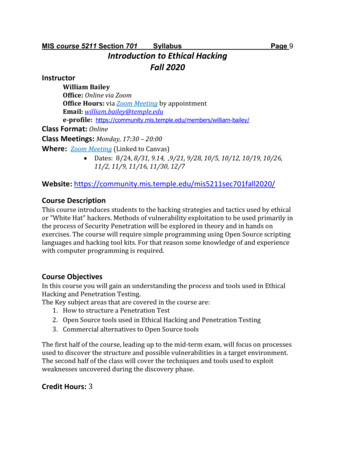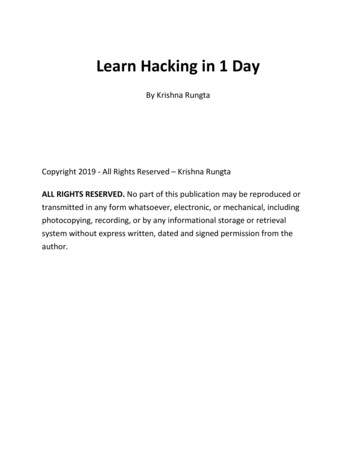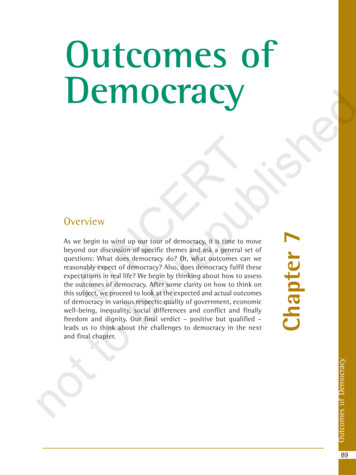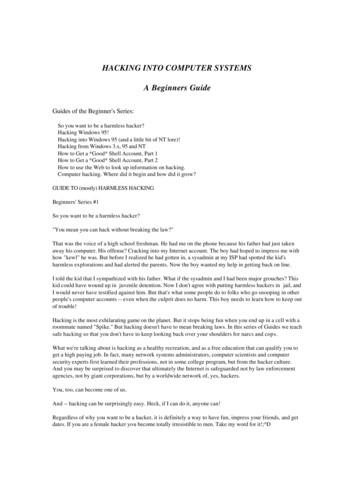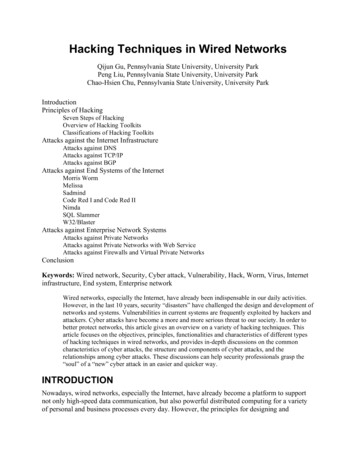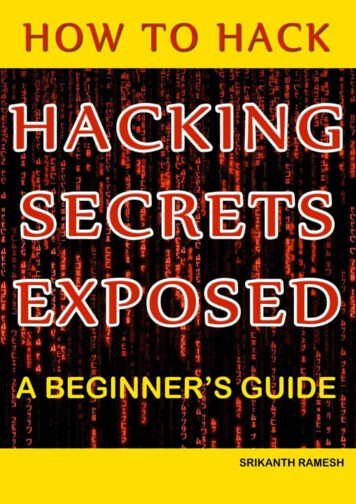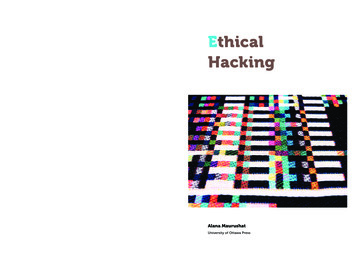
Transcription
Hacking democraciesCataloguing cyber-enabled attacks on electionsFergus Hanson, Sarah O’Connor, Mali Walker and Luke CourtoisPolicy BriefReport No. 16/2019
About the authorFergus Hanson is the head of ASPI’s International Cyber Policy Centre. He is the author of Internet wars and has published widely inAustralian and international media on a range of cyber and foreign policy topics. He was a visiting fellow at the Brookings Institutionand a Professional Fulbright Scholar based at Georgetown University working on the take-up of new technologies by the US Government.He has worked for the United Nations and as a program director at the Lowy Institute and served as a diplomat at the AustralianEmbassy in The Hague. He has been a fellow at Cambridge University’s Lauterpacht Research Centre for International Law and theCentre for Strategic and International Studies, Pacific Forum.Sarah O’Connor is a researcher working with ASPI’s International Cyber Policy Centre. Sarah holds a Bachelor of International Relations(Hons.) and Graduate Certificate in Law from the Australian National University (ANU), and is currently undertaking a Masters ofInternational Law at ANU. Her research interests include international law, cybersecurity, and the future of warfare and technology.Mali Walker is an ASPI research intern.Luke Courtois is an ASPI research intern.What is ASPI?The Australian Strategic Policy Institute was formed in 2001 as an independent, non‑partisan think tank. Its core aim is to provide theAustralian Government with fresh ideas on Australia’s defence, security and strategic policy choices. ASPI is responsible for informingthe public on a range of strategic issues, generating new thinking for government and harnessing strategic thinking internationally.ASPI International Cyber Policy CentreThe ASPI International Cyber Policy Centre’s mission is to shape debate, policy and understanding on cyber issues, informed by originalresearch and close consultation with government, business and civil society.It seeks to improve debate, policy and understanding on cyber issues by:1. conducting applied, original empirical research2. linking government, business and civil society3. leading debates and influencing policy in Australia and the Asia–Pacific.The work of ICPC would be impossible without the financial support of our partners and sponsors across government, industry and civilsociety. This research was made possible thanks to the generous support of the Australian Computer Society (ACS).Important disclaimerThis publication is designed to provide accurate and authoritative information in relation to the subject matter covered. It is provided withthe understanding that the publisher is not engaged in rendering any form of professional or other advice or services. No person shouldrely on the contents of this publication without first obtaining advice from a qualified professional.ASPITel 61 2 6270 5100Fax 61 2 6273 9566Email SPI.org@ASPI ICPC The Australian Strategic Policy Institute Limited 2019This publication is subject to copyright. Except as permitted under the Copyright Act 1968, no part of it may in any form or by any means(electronic, mechanical, microcopying, photocopying, recording or otherwise) be reproduced, stored in a retrieval system or transmittedwithout prior written permission. Enquiries should be addressed to the publishers. Notwithstanding the above, educational institutions(including schools, independent colleges, universities and TAFEs) are granted permission to make copies of copyrighted works strictly foreducational purposes without explicit permission from ASPI and free of charge.First published May 2019Cover image: Illustration by Wes Mountain. ASPI ICPC and Wes Mountain allow this image to be republished under the Creative CommonsLicense Attribution-Share Alike. Users of the image should use the following sentence for image attribution: ‘Illustration by Wes Mountain,commissioned by the Australian Strategic Policy Institute’s International Cyber Policy Centre.’
Hacking democraciesCataloguing cyber-enabled attacks on electionsFergus Hanson, Sarah O’Connor, Mali Walker and Luke CourtoisPolicy BriefReport No. 16/2019
ContentsForeword 03What’s the problem? 04What’s the solution? 04Introduction 05Project overview and methodology 07Findings 08Country analysis 08China’s versus Russia’s motivations 09Methods 09Types of interference 10Findings and recommendations 17Appendix: Examples of foreign interference (November 2016 to March 2019) 19Notes 29Acronyms and abbreviations 02Policy Brief: Hacking democracies: Cataloguing cyber-enabled attacks on elections31
ForewordOne of the great hopes for the internet was that it would herald a new era in thedemocratisation of information. To a large extent, it’s been successful. So successful,in fact, that global platforms, technology diffusion and mobility have brought someunintended consequences by enabling the rapid dissemination of disinformationand fake news.We live in a time when trust in our democratic and other key institutions hasdeclined, and this is compounded by new capabilities of adversaries seeking tointerfere in our elections and to undermine people’s trust in those institutions.In this policy brief, the writers explore areas where interference has been detected across the worldand consider key learnings from those examples in order to develop policy responses for counteringeach type of interference.Technology has the power to transform lives by reducing barriers to entry and creating greater equityso that all our citizens can participate in education and the economy. We want to live in a world wherefriction is removed and technology enhances our experience, where all citizens have access to theinternet, and where we can vote electronically in elections. However, our interconnection needs to besafe and trusted, protecting and enhancing our democracies.This brief starts an important national conversation, generating awareness of the approachescommonly taken by adversaries to spread disinformation, misinformation and fake news. It lays out aseries of measures for managing risk, and serves as an educational resource for our citizens on whatto keep an eye out for, and how to better distinguish reputable information from disinformation inreal time.Yohan RamasundaraPresident, Australian Computer Society03
What’s the problem?Analysis of publicly known examples of cyber-enabled foreign interference in elections reveals keychallenges. First, while perceptions of interference are widespread, the actors are few—Russia andChina—and the effort is highly targeted. Russia is targeting the US and Europe (with a few forays intoSouth America), while China targets its region (having, for the moment, reached as far as Australia).Second, the methods used can be hard to pick up and democracies seem poorly equipped to detectintrusions, being traditionally focused on external intelligence collection. Adversaries are able toenter public debates, infiltrate legitimate activist networks and even enter the mainstream media astrusted commentators. Significant activity may be being missed. Finally, while opinion polling showsconcerning levels of dissatisfaction with democracy and weakening trust in public institutions, it’s verydifficult to assess the impact of election interference on those phenomena. It’s likely to have someimpact but be outweighed by larger societal factors.What’s the solution?First, the response from democracies should be calibrated to the likely risk and adversary. The USand European states are clear targets of Russia; Indo-Pacific nations are targets of the ChineseCommunist Party (CCP). Second, more effort is needed to detect foreign interference, including offlineand non-state efforts. Because democracies have a natural aversion to government surveillance,a better answer than simply stepped-up government monitoring may be supporting non-profit,non-government initiatives and independent media. Third, effort is needed to develop better waysto measure the impact of foreign interference to allow for a more informed decision on resourcingefforts to counter it. Notwithstanding the lack of current empirical data on impact, opinion pollingpoints to a perception that foreign interference will occur and, in places such as the US, a view bymany that the 2016 presidential election was swayed by it (a credible view, given the narrowness ofthe outcome). Research is needed to measure the effectiveness of different education and awarenessefforts to address these concerns. Fourth, public funding may be needed to better secure politicalparties and politicians from cyber intrusions. Finally, democracies need to impose costs on thetwo primary state actors: they should consider joint or regional action to make future or continuedinterference sufficiently costly to those states that they will no longer pursue it. Legislation may alsobe needed to make it more difficult for foreign adversaries to operate (being mindful of the differingobjectives of the two main actors); this may be a second best for countries that find it too difficult tocall out adversaries.04Policy Brief: Hacking democracies: Cataloguing cyber-enabled attacks on elections
IntroductionIn 2016, Russia comprehensively and innovatively interfered in the US presidential election, offering atemplate for how democracies around the world could be manipulated.1 Since then there have been194 national-level elections in 124 countries and an additional 31 referendums.2 This report seeks tocatalogue examples of foreign interference in those polls and group them into three ‘buckets’: interference targeting voting infrastructure and voter turnout interference in the information environment (to make the scope manageable, we have focused oninterference surrounding elections, but it’s apparent that such efforts continue outside electionperiods as part of longer term efforts to manipulate societies) longer term efforts to erode public trust in governments, political leadership and public institutions.This research focused on cyber-enabled interference (including, for example, information operationsthat harness social media and breaches of email and data storage systems), but excluded offlinemethods (for example, the financing of political parties and the suborning of prominent individuals).The yardstick for counting an activity as interference was that proposed by former Prime MinisterMalcolm Turnbull, who put it this way when introducing counter-foreign-interference laws in Australiain 2017: ‘we will not tolerate foreign influence activities that are in any way covert, coercive or corrupt.That’s the line that separates legitimate influence from unacceptable interference.’3A major issue has become the public perception that results may have been swayed, withconsequences for the direction of these states’ policies and actions, together with a loss of public trustin democratic institutions and processes.Multi-country Pew Research Center polling shows that there’s an increasing expectation amongglobal publics that elections will suffer interference: majorities (including 65% of Australians) in 23 of26 countries surveyed in 2018 said it was very or somewhat likely that a cyberattack would result intheir elections being tampered with.4In some cases, such as the 2016 US presidential election, polling shows that a large proportion ofpeople (39% of US adults) feel that Russian meddling swung the election,5 which is probably the mostvaluable outcome Russia could have hoped for, given that it’s seeking to undermine confidence in USglobal leadership and the US public’s faith in the nation’s democratic process.6Since that election, reports of foreign interference in democratic elections have continued to surface.This suggests a belief among adversary states that interference is serving their interests and that thecosts of action are not sufficiently high to deter this behaviour.Of course, foreign governments interfering in elections is nothing new.7 While the objectives might besimilar to those of Cold War style efforts, the means are different. Today, a state such a Russia is ableto reach more than a hundred million Americans through a single platform such as Facebook withoutsending a single operative into US territory.8 Or, as nearly happened in Ukraine, the official electionresults can be remotely altered to show a candidate who received just 1% of the vote as winning.905
And, significantly, a little effort goes a long way: in 2016, Russian operatives were able to organisetwo opposing groups to engage in a protest in front of the Islamic Da’wah Centre of Houston for‘the bargain price of 200’.10 Having a big impact is now much easier, cheaper and less risky.For democratic governments, responding can be extremely difficult. The methods used by adversariestypically exploit treasured democratic principles such as free speech, trust and openness. Detectioncan be hard both because the methods are difficult to identify and because democracies avoidsurveillance of their own domestic populations and debates (outside niche areas such as traditionalcriminal and terrorist activity). Typically, the bulk of intelligence resources is directed towards externalcollection, and domestic populations are rightly wary of increased government monitoring.Democratic governments themselves can be obstacles: if the winning party believes it benefitedfrom the foreign interference or would be delegitimised by admitting its scale, it can even mean thenewly elected government will play down or ignore the interference. Tensions in the US in the wake ofRussian interference in the 2016 election point to the potential for these sorts of issues to arise.11Measuring levels of interference and adversary’s objectives is another challenge. Given the difficulty ofdetection and the variance in methods employed, it’s hard to compare relative levels of interferenceacross elections. Objectives are also not always straightforward. Most efforts to interfere in electionsare not about directly altering the vote count. Instead, many appear aimed at disrupting societiesor undermining trust in important institutions. There also appear to be different overarching aimsdepending on the adversary involved.06Policy Brief: Hacking democracies: Cataloguing cyber-enabled attacks on elections
Project overview and methodologyThis research was generously supported by the Australian Computer Society and stemmed from aseries of engagements with policymakers on countering election interference. Desk research andinterviews focused on developing a database of cyber-enabled foreign interference in democraticelections. It was informed by a full-day workshop in London involving several electoral commissionerequivalents from around the world as well as the President of the Australian Computer Society. A keyfocus of the workshop was the development of a framework for mapping election interference with aview to improving the policy response.The start date for the research was the 2016 US presidential election and the end date was March2019. During that period, this research identified 194 national-level elections in 124 countries and anadditional 31 referendums.Using Freedom House’s Freedom in the world report,12 of the 124 states that have held nationalelections since November 2016, 53 are considered ‘free’, 45 ‘partly free’ and 26 ‘not free’. Given thefocus of this report on democracies, we limited the research scope to the 97 countries that heldelections and that were deemed free or partly free.As noted above, examples of foreign interference were grouped into three buckets. This built off andexpands on a framework in the International Cyber Policy Centre’s Securing democracy in the DigitalAge report.13Categorising incidents was an inexact science. Often there was a lack of publicly available informationabout the case (many media reports described ‘hacks’ without elaborating), or it might easily straddlemore than one category. Consider the intrusion into Australia’s parliament and three political partiesreported by Prime Minister Scott Morrison on 18 February 2019,14 suspected to have been carried outby Chinese state-sponsored actors. The intent behind this incident is still unclear.Was it solely espionage or an act of foreign interference?15 The sophisticated state actor has notseemed to use any material obtained to interfere in the current election. That may be because of thediscovery of the intrusions, or because the information obtained is being used for a different purpose(as suggested by ASPI’s Michael Shoebridge16). For the purposes of this report, it was classified as‘long-term erosion of public trust’, given that the public reporting highlighted inadequate securityamong core Australian institutions.This report captures examples of interference that were executed (for example, Russian onlinedisinformation campaigns that ran on social media during the 2016 US presidential election) andthose that were discovered but not executed (such as Russians’ accessing of US voter rolls duringthat election without manipulating or using them).07
FindingsOf the 97 national elections in free or partly free countries reviewed for this report during the periodfrom 8 November 2016 to 30 April 2019, a fifth (20 countries) showed clear examples of foreigninterference, and several countries had multiple examples (see the appendix to this report).17 It’s worthnoting that confidence in attributions to foreign actors varied widely. In ideal circumstances, agovernment source made the attribution, but often the attribution was more informal. Our intentionwas not to provide an exhaustive list of every alleged case of foreign interference but instead tocapture the spread of states experiencing the phenomenon and illustrative examples of differentmethods. Details on all examples identified through this research are set out in the appendix.Country analysisOf the 97 elections and 31 referendums reviewed, foreign interference was identified in 20 countries:Australia, Brazil, Colombia, the Czech Republic, Finland, France, Germany, Indonesia, Israel, Italy, Malta,Montenegro, the Netherlands, North Macedonia, Norway, Singapore, Spain, Taiwan, Ukraine andthe US.Of those 20 states, 14 were deemed ‘free’ and 6 ‘partly free’. Just over half (12 of 20) of the states werein Europe, which is unsurprising given Russia’s leading role in this area (Table 1).Table 1: Regional spread (alleged actor)EuropeAsia–PacificMiddle EastAmericasCzech Republic (Russia)Australia (China)Israel (Iran)Brazil (Russia)Finland (Russia)Indonesia (China/Russia)Colombia (Russia/Venezuela)France (Russia)Singapore (China)US (Russia)Germany (Russia)Taiwan (China)Italy (Russia)Malta (Russia)Montenegro (Russia)Netherlands (Russia)North Macedonia(UK/Russia)Norway (Russia)Spain (Russia)Ukraine (Russia)Table 1 shows the strong geographical link between the target and actor. With the exception ofone anomalous case involving the UK (which was alleged to have supported a Yes campaign in aMontenegrin referendum), Russia was the only state interfering in European elections. Similarly, in theIndo-Pacific, China was the only actor (except for Indonesia, where Russia was also involved). Iran’sinterference in Israel has a clear connection to its adversarial relationship. In the Americas, there’smore diversity among the actors, but Russia remains the dominant player.08Policy Brief: Hacking democracies: Cataloguing cyber-enabled attacks on elections
China’s versus Russia’s motivationsRussia’s and China’s interference reflect different national approaches. For Russia, a key objective is toerode public trust in democracies and to undermine the idea that democracy is a superior system.18This might be driven by President Putin’s personal drive to make the West ‘pay’ for its destructionof the Soviet bloc and by the desire to mount a case inside Russia that democracies are flawed andtherefore not a model that Russians should aspire to. As a consequence, Russian interference isinherently destructive to democratic systems, even at the same time as Moscow may seek to promotea party or a candidate thought to be more sympathetic to its interests.19Chinese interference seems more strategically focused on ensuring that its interests are promotedacross all party lines. Unlike the Russian stance, one party’s interests don’t appear to be favoured atthe expense of others (with the exception, perhaps, of Taiwan20). Instead, all consequential parties arein its crosshairs with a view to making them more sensitive to core CCP interests. China also seems topursue a broader front of influencing activities (many of which aren’t captured by this report’s focuson cyber-enabled methods), which can include financial donations,21 aligning the policy interestsand public comments of party figures to CCP political goals and suborning prominent individuals toadvocate for Beijing’s interests. China doesn’t seem to be as openly intent on doing damage to thecredibility of foreign political systems so much as aligning those systems to its strategic objectives.22MethodsA review of the dataset reveals considerable repetition in methods. There are multiple examplesof social media platforms being exploited to reach target populations, often used in concert withstate-sponsored media outlets. There is, however, considerable variation in the way social mediaare exploited. This ranges from organising rallies and amplifying the voices of favoured groups tosuppressing voter turnout and exacerbating existing divisions.23 There are also several examples ofsystem breaches, again to pursue different ends, including stealing and leaking emails and accessingvoter rolls.Given the lack of detail in many media reports on foreign interference, it’s difficult to provide a list ofthe most common methods. Frequency of use also does not translate into impact. For example, thebreach of one person’s email account (such as the account of Hillary Clinton’s campaign chair, JohnPodesta) can have much greater impact than any single social media post or perhaps all of them.09
Types of interferenceThis section examines our three defined buckets of interference.Targeting of voting infrastructure and voter turnoutDirect tampering with election results is perhaps the most affronting form of foreign interferencebecause it most directly overturns the will of the people.Ukraine has long been one of the main targets of Russian election interference efforts and hasalso suffered the most egregious effort to alter the technical results of an election. As Mark Claytonreported back in 2014 (a date outside the scope of the mapping period covered by this report):Only 40 minutes before election results were to go live on television at 8 p.m., Sunday, May 25,a team of government cyber experts removed a ‘virus’ covertly installed on Central ElectionCommission computers, Ukrainian security officials said later.If it had not been discovered and removed, the malicious software would have portrayedultra-nationalist Right Sector party leader Dmytro Yarosh as the winner with 37 percent of the vote(instead of the 1 percent he actually received) and Petro Poroshenko (the actually [sic] winner with amajority of the vote) with just 29 percent, Ukraine officials told reporters the next morning.24There are multiple means by which adversary states could interfere with the technical results ofelections. Various methods could be used to prevent citizens from being able to vote (for example, byrendering electronic voting booths unusable or corrupting the voter roll so eligible voters are removedand turned away from voting booths25) or reducing the turnout of certain voter groups with knowndominant voting behaviours (for example, via online campaigns that encourage a boycott 26 or targetedmisinformation that has the effect of deterring certain voter groups27).The result itself could be altered via various means. Electronic voting booths could be maliciouslyprogrammed to record a vote for Candidate A as a vote for Candidate B instead, the transmission ofvotes tallied at individual voting booths could be intercepted and altered, affecting the final tally, votesin the central tally room or system could be altered remotely or, as was attempted in Ukraine, therelease of the vote outcome could be tampered with (a tactic unlikely to go unnoticed, but likely to castdoubt among some about the integrity of the poll and of the national electoral system).Research for this report identified six countries that had experienced interference targeted at votinginfrastructure and voter turnout: Colombia, Finland, Indonesia, North Macedonia, Ukraine and the US(Table 2).Table 2: Targeting of voting infrastructure and voter dRussiaIndonesiaRussia/ChinaNorth MacedoniaRussiaUkraineRussiaUSRussiaPolicy Brief: Hacking democracies: Cataloguing cyber-enabled attacks on elections
Examples included the targeting of voter registration rolls in Colombia,28 Indonesia29 and 21 USstates,30 a denial of service (DoS) attack on a Finnish web service used to publish vote tallies,31 adistributed denial of service (DDoS) attack on Ukraine’s Central Election Commission,32 and the useof social media to suppress voter turnout in North Macedonia33 and in the US.34 In the US, an OxfordUniversity report noted that Russian operatives tried to suppress the vote of African-Americans bypushing the narrative that ‘the best way to advance the cause of the African American community wasto boycott the election and focus on other issues instead’.35 While it’s difficult to determine the effect ofthe disinformation campaign by Russia’s Internet Research Agency, the Pew Research Centre reportedthat the voter turnout of African-Americans fell in 2016 (see appendix, page 19).36The attackers identified in public reports (sometimes speculatively) were Russia (in one instance,combined with Venezuela) and China. Russia was by far the dominant actor.Interference in the information environment around electionsIt’s difficult to detect foreign interference during elections with high confidence in a timely manner.Consider this example from Bret Schafer, which fooled multiple media outlets:Have you met Luisa Haynes? She was a prolific force in the #BlackLivesMatter community onTwitter. In just over a year, she amassed more than 50,000 followers; and her outspoken, viral takeson everything from Beyoncé to police brutality earned her hundreds of thousands of retweets andmedia coverage in more than two dozen prominent news outlets.She was, on the surface, a symbol of a new generation of Black activists: young, female, anddigitally savvy—except—she was fake.37At the International Cyber Policy Centre, journalists periodically approach us about websites and socialmedia accounts they suspect are run by foreign agents or trolls. Mostly, investigations lead to deadends, or to apparently real people who are hard to definitively classify as foreign trolls rather thancolourful citizens.Now that the traditional media have lost their old gatekeeper role and control over the informationenvironment, it’s far easier for foreign adversaries to inject themselves into national debates andmuch harder to trust what you’re reading and seeing. When Australians were asked in 2018 ‘Do youfeel like the news you read or watch gives you balanced and neutral information?’, 54% said ‘never’ or‘rarely’. There were similar results in democracies around the world38 (in historical terms, in the US theproportion of people reporting ‘a great deal’ and ‘quite a lot’ of confidence in newspapers has droppedfrom a high of 39% in 1990 to 23% in 201839).While avenues for altering the technical results of elections are limited, opportunities to manipulatethe information environment are limited only by creativity. Methods might include amplifying a party’sexisting narrative using social media accounts that have assiduously built up followers over lengthyperiods,40 or creating and spreading disinformation to undermine a candidate (for example, thestate-owned Russian news agency Sputnik calling French presidential candidate Emmanuel Macronan agent of ‘the big American banking system’).41 It might involve infiltrating genuine activist groupsand attempting to increase polarisation,42 or it could involve the creation of fake personas who provide11
inflammatory commentary on divisive issues, as with Luisa Haynes. Often such campaigns seek toprey on and exacerbate existing social cleavages with a view to exploiting them to manipulate theinformation environment in the desired direction.While the impact of this manipulation isn’t as direct as interfering with key election infrastructure,its ease and cheapness, combined with the difficulty of timely detection, make it a preferred method.Foreign interference in the information environment was identified in 10 states: France, Israel, Italy,Malta, the Netherlands, North Macedonia, Spain, Taiwan, Ukraine and the US (Table 3).Table 3: Interference in the information ussiaMaltaRussiaNetherlandsRussiaNorth MacedoniaRussia / ussiaExamples included information disruption campaigns targeting French presidential candidateEmmanuel Macron (such as the theft and release of 21,000 emails just before the final vote inthe election—a technique likely to be of enduring utility for adversaries)43 and the spreading ofdisinformation by Russian media outlets Russia Today (RT) and Sputnik in Catalonia44 and Italywith headlines like ‘Migrant chaos, the beginning of a social war’45 or claiming in the Macedonianreferendum that, depending on who won, Google would remove Macedonian from i
04 Policy Brief: Hacking democracies: Cataloguing cyber-enabled attacks on elections. Introduction In 2016, Russia comprehensively and innovatively interfered in the US presidential election, offering a template for how democracies around the world could be manipulated.1 Since then there have been

